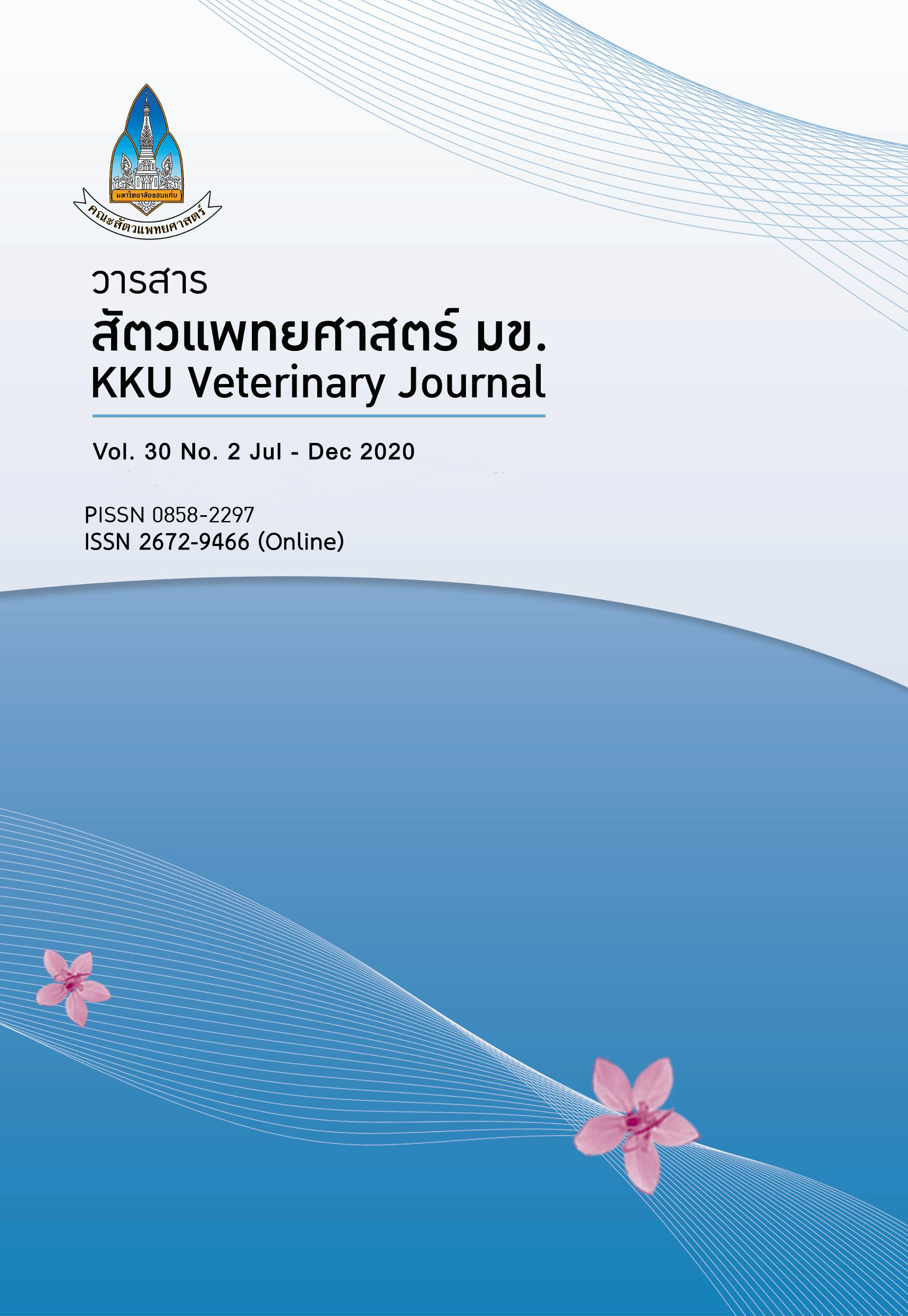ค่าตัวแปรของหัวใจกระต่ายเลี้ยง ด้วยภาพถ่ายรังสีช่องอกและคลื่นไฟฟ้าหัวใจ
Main Article Content
บทคัดย่อ
วัตถุประสงค์ การศึกษาค่าตัวแปรที่สำคัญของหัวใจ ได้แก่ ขนาดหัวใจ อัตราการเต้นของหัวใจ และคุณสมบัติทางคลื่นไฟฟ้าหัวใจ ในกระต่ายเลี้ยงสุขภาพดี ด้วยวิธีการวัด Vertebral heart score (VHS) และ Electrocardiogram (ECG) เพื่อเปรียบความแตกต่างค่าพารามิเตอร์ในกระต่ายแต่ละสายพันธุ์
วัสดุ อุปกรณ์ และวิธีการ ทำการตรวจเพื่อทำการคัดเลือกกระต่ายสุขภาพดี จำนวน 99 ตัว โดยไม่คำนึงถึงเพศ อายุ หรือน้ำหนัก จากนั้นแบ่งกระต่ายเป็น 3 กลุ่มคือ สายพันธุ์ฮอลแลนด์ลอป ไทย และเนเธอร์แลนด์ดวอร์ฟ จากนั้นวางยาสลบเพื่อให้อยู่ในสภาวะที่สงบ โดยฉีดไซลาซีนไฮโดรคลอไรด์ร่วมกับเคตามีนไฮโดรคลอไรด์เข้ากล้ามเนื้อ จากนั้นทำการถ่ายภาพทางรังสีช่องอกเพื่อวัดขนาดหัวใจ ในท่านอนหงายและตะแคงขวา การวัดคลื่นไฟฟ้าหัวใจ ด้วยวิธีการวัด Vertebral heart score (VHS) และ Electrocardiogram (ECG)
ผลการศึกษา ในกระต่ายสายพันธุ์ฮอลแลนด์ลอป 51 ตัว ไทย 32 ตัว และเนเธอร์แลนด์ดวอร์ฟ 16 ตัว พบว่าอัตราส่วนขนาดหัวใจต่อขนาดทรวงอก มีอัตราส่วนไม่เกินร้อยละ 60 ทั้งในภาพรังสีท่านอนตะแคงขวาและท่านอนหงาย ในท่าตะแคงขวาพบว่าขนาดหัวใจด้านกว้าง ด้านยาว และขนาดโดยรวม ไม่มีความแตกต่างกันระหว่างกลุ่ม อัตราการเต้นและคลื่นไฟฟ้าหัวใจ P wave (s), P wave (mV), PR interval (s), QRS complex (s), R wave (mV) และT wave (s) พบว่าไม่มีความแตกต่างกันระหว่างกลุ่ม แต่พบว่า QT interval (s) มีความแตกต่างในสายพันธุ์ฮอลแลนด์ลอปกับไทย (P<0.05) ลักษณะ ST segment ที่แตกต่างจากสัตว์ชนิดอื่นพบว่ามี ST elevation ร้อยละ 56.6 โดยค่าสูงสุดอยู่ที่ 0.12 mV ส่วน ST depression ไม่มีการพบ และ MEA ทั้งหมดอยู่ในช่วงระหว่าง -90 ถึง 180 องศา โดยร้อยละ 55.6 อยู่ในช่วงระหว่าง -30 ถึง 90 องศา ซึ่งเป็นค่าปกติเมื่อเทียบกับในมนุษย์ ร้อยละ 7.1 อยู่ในช่วงระหว่าง -30 ถึง -90 องศา และร้อยละ 37.4 อยู่ในช่วงระหว่าง 90 ถึง 180 องศา ไม่มีช่วง -90 ถึง -180
ข้อสรุป ขนาดของหัวใจและอัตราการเต้นของหัวใจในกระต่ายทั้งสามสายพันธุ์ไม่มีความแตกต่างกัน คลื่นไฟฟ้าหัวใจพบว่ามีเฉพาะ QT interval (s) ที่มีความแตกต่างกัน ส่วน ST elevation ที่เกิดขึ้นมีความแตกต่างกับค่าปกติในสุนัขและแมว แต่ไม่เกินค่าปกติในมนุษย์ และ MEA อยู่ในระหว่าง -90 ถึง 180 องศา
Article Details
เอกสารอ้างอิง
Wanwarang Wongcharoen, Arinthaya Phonminthikun, Narawutt Prasertwitthayakit, Rangsarit Kanchanawanit , Apichat Sukhonsan. 2014. Electrocardiography for medical student. 8th edition. Thailand, Chaingmai: Trick Thimk, 11-41.
Alexander JH. 2005. Comparative cardiac anatomy. In Paul AI (Ed.). Handbook of cardiac anatomy, physiology and devices. New Jersey: American International Standard institute, 81-91
Ali AS, Nasser V, Nikahval B, Alireza K. 2009. Comparison of the Effects of different doses of acepromazine-xylazine on the electrocardiogram in dogs. Iran J Vet Res 33(3), 208-215.
Anthony D, Sarah V. 2005. Basic ECG theory, recordings and interpretation. In Paul AI (Ed.). Handbook of cardiac anatomy, physiology and devices. New Jersey: American international standard institute, 191-201.
Atkins C, Bonagura J, Ettinger S, Fox P, Gordon S, Haggstrom J, Hamlin R, Keene B, Luis-Fuentes V, Stepien R. 2009. Guidelines for the diagnosis and treatment of canine chronic valvular heart disease. J Vet Intern Med 23(6), 1142–1150.
Buchanan JW, Bucheler J. 1995. Vertebral scale system to measure canine heart size in radiographs. J Am Vet Med Assoc 206(2), 194-199.
Canavese F, Dimeglio A, Barbetta D. 2014. Effect of thoracic arthrodesis in prepubertal New Zealand White rabbits on cardio-pulmonary function. Indian J Orthop 48(2), 184–192.
Cassu RN, Melchert A, Canoa JT, Martins PD. 2014. Sedative and clinical effects of the pharmacopuncture with xylazine in dogs. Acta Cir Bras 29(1), 47-52.
Chari YTH, John CBJr, Margaret MR. 2001. Effects of avertin versus xylazine-ketamine anesthesia on cardiac function in normal mice. Am J Physiol 281(5), 1938-1945.
Chitty J. 2015. Cardiovascular disease in rabbits. Companion Anim J 20(2), 74-78.
Carinci F, Martinelli M, Contaldo M, Santoro R, Pezzetti F, Lauritano D, Candotto V, Mucchi D, Palmieri A, Tagliabue A, Tettamanti 7. 2018. Focus on periodontal disease and development of endocarditis. J Biol Reg Homeos Ag 32(2), 143-147.
Deeb BJ, DiGiacomo RF. 2000. Respiratory diseases of rabbits. Vet Clin North Anim Exotic Anim Pract 3(2), 465-480.
Harcourt-Brown F. 2002. Textbook of Rabbit Medicine. 2nd edition. Burlington: Butterworth-Heinemann.
Jepsen GK, Pollard RE, Johnson LR. 2013. Vertebral heart scores in eight dog breeds. Vet Radiol Ultrasound 54(1), 3-8.
Larry T, Francis S, Mark O, Meg S. 2008. Electrocardiography. manual of canine and feline cardiology (4th Edition). Philadelphia: Saunders Elsevier. 464.
Lord B, Devine C, Smith S. 2010a. Congestive heart failure in two pet rabbits. Jo Small Anim Pract 52(1), 46-50.
Lord B, Boswood A, Petrie A. 2010b. Electrocardiography of the normal domestic pet rabbit. Vet Rec 167(25), 961-965.
Loscalzo J (Ed.). 2013. Harrison’s Cardiovascular Medicine. 2nd edition. United States: McGraw-Hill Education.
Marini RP, Li X, Harpster NK. 1999. Cardiovascular pathology possibly associated with ketamine/xylazine anaesthesia in Dutch belted rabbits. Lab Anim Sci 49(2), 153–160.
Nabi SU, Wani AR, Dey S. 2014. Radiographic measurements (vertebral heart scale) of popular breeds of dogs in India. Appl Biol Res 16 (2), 242-246.
Naglaa AG, Alaa G, Ayman A. 2015. Effect of repeated intravenous administration of xylazine on sedation, analgesia and ECG parameters in donkeys (Equus Asinus). Assiut Vet Med J 61(147), 130-136.
Pariaut R. 2009. Cardiovascular physiology and diseases of the rabbit. Vet Clin North Ame Exotic Anim Pract 12(1), 135-144.
Plonsey R. 1982. Electrocardiographic lead theory and lead systems. In Plonsey R, Liebman J, Gillette PC. (Eds.). Pediatric electrocardiography. Baltimore: Lippincott Williams & Wilkins. 26-39.
Praag EV. 2015. Congestive heart failure in rabbits. Retrieved January 19, 2019, from https://www.researchgate.net/publication/272151346_Congestive_heart_failure_in_rabbits.
Ruben CS, Matthew R, Dorcas O, Karen O, Chad RF, Corinne AW, Amanda GA, David AB. 2011. High doses of ketamine–xylazine anesthesia reduce cardiac ischemia–reperfusion injury in guinea pigs. J Am Assoc Lab Anim Sci 50(3), 349–354.
Shree VD, Milind SD, Basavraj SN. 2017. Periodontitis, bacteremia and infective endocarditis: a review study. Pediatr Infect Dis 5(3): e41067.
Turner GA, Ayres DA, Lima L. 2015. Determination of normal echocardiographic, electrocardiographic, and radiographic cardiac parameters in the conscious New Zealand White rabbit. J Exotic Pet Med 24(2), 223-234.
Weerakhun S. 2015. Rabbit Gastrointestinal Syndrome. Processing of the 16th KhonKaen university veterinary international annual conference, KhonKaen University, KhonKaen, Thailand.
Wendy AW. 2011. Cardiovascular disease in small animal medicine. 3rd ed. London: Manson Publishing Ltd.


